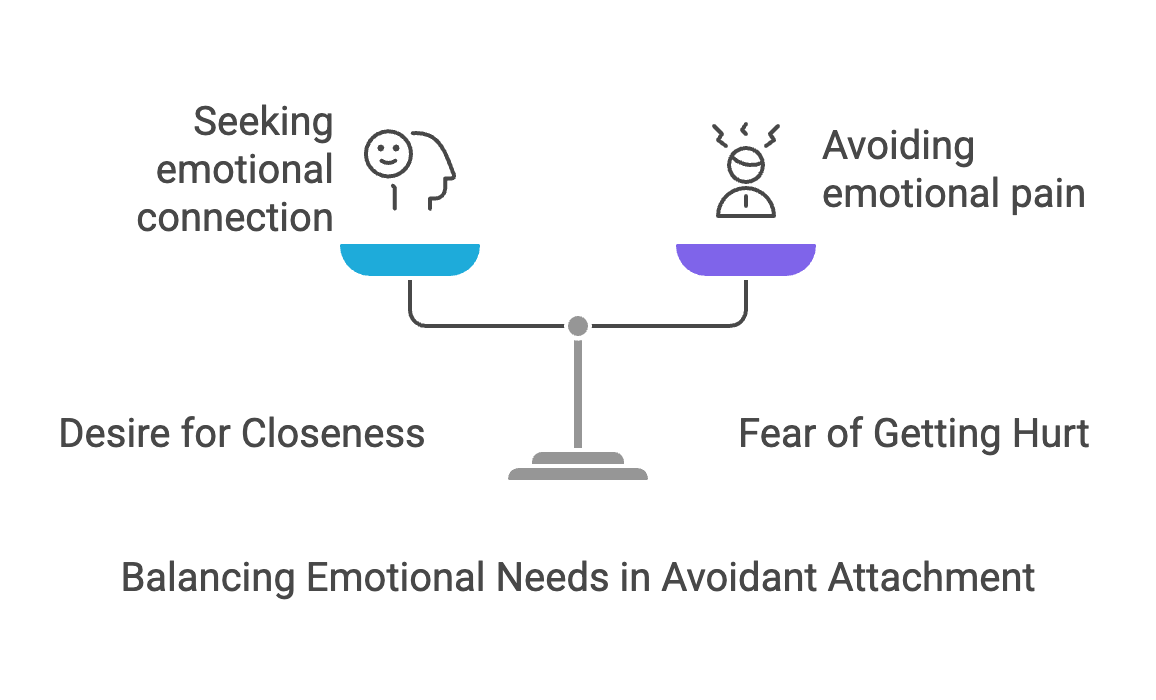Are you looking to date someone with a fearful, avoidant attachment style?
You might feel puzzled by their mixed signals and wonder if they truly care. These individuals often show their affection differently – pulling away one moment and coming closer the next.
Their actions can leave partners scratching their heads, trying to decode what’s really going on in their hearts.
This blog will help you spot genuine signs of love from a fearful avoidant partner.
While they may struggle to express feelings verbally, their behaviors tell a deeper story. Understanding these subtle cues can strengthen your connection and build trust in the relationship.
Understanding Avoidant Attachment
An avoidant attachment style forms early in childhood when caregivers aren’t consistently present for emotional needs.
Think of it like a protective shield – these individuals learned to rely heavily on themselves rather than others.
While most people lean in during tough times, someone with avoidant attachment tends to step back. It’s similar to a cat that wants attention but runs away when you get too close.
This push-pull pattern comes from two competing needs: the desire for closeness and the fear of getting hurt.
When stress hits, they often retreat into their personal space. This doesn’t mean they don’t value the relationship – quite the opposite.
Their withdrawal actually shows they’re trying to process emotions and protect both themselves and their partner from potential pain.
Key Signs Fearful Avoidant Loves You Deeply

While avoidant partners may not always wear their hearts on their sleeves, there are subtle yet powerful signs that reveal their deep love for you.
- Remember Small Details: When your fearful, avoidant partner mentions the name of your childhood pet or recalls your coffee order perfectly, pay attention. This shows they listen carefully and store away bits of information about you, even if they seem distant at times.
- Check on You During Hard Times: Despite their tendency to pull away, they send a quick text or call when you’re sick or stressed. These small gestures mean they’re thinking of you, even when maintaining distance.
- Share Their Vulnerable Side: Opening up about fears or past experiences takes tremendous trust. When they tell you about their worries or childhood memories, they’re showing real emotional connection.
- Make Future Plans: A fearful avoidant who suggests weekend trips or makes holiday plans is working against their usual tendency to avoid commitment. This shows they see you in their future.
- Return After Taking Space: While they might need alone time, they consistently come back and reconnect. This pattern shows they value the relationship enough to work through their fears.
- Introduce You To Their Inner Circle: Meeting close friends or family is significant. It means they trust you enough to blend you into their personal world.
- Show Physical Affection: Simple touches like holding hands or giving hugs, especially in private moments, indicate they feel safe with you physically and emotionally.
- Notice Changes in Your Mood: When they ask “what’s wrong?” before you’ve said anything, it shows they pay attention to your emotional state and care about your well-being.
- Keep Their Promises: Following through on commitments, even small ones, demonstrates they respect you and want to maintain trust.
- Send Random Messages: Quick texts about their day or funny memes show you’re on their mind, even during busy times.
- Include You in Decisions: Asking your opinion about their choices shows they value your input and see you as part of their life.
- Remember Important Dates: Noting birthdays, anniversaries, or other special occasions shows thoughtfulness and emotional investment.
- Show Up During Emergencies: Setting aside their need for space to support you during crises demonstrates deep care and commitment.
- Create Special Moments: Planning dates or surprising you with your favorite treats shows an effort to make you happy.
- Defend You to Others: Standing up for you in front of others reveals protective feelings and loyalty.
- Let You Into Their Space: Sharing their personal space or giving you a key shows trust and comfort with closeness.
- Ask About Your Day: Regular questions about your life show genuine interest in your experiences and feelings.
- Accept Your Help: Allowing you to support them during tough times shows growing trust and vulnerability.
- Share Their Belongings: Lending personal items or sharing passwords indicates growing trust and security.
- Show Jealousy: Subtle signs of jealousy, while maintaining respect, can indicate deeper attachment.
- Remember Your Preferences: Noting your likes and dislikes in daily choices shows attention to your happiness.
- Make Time for You: Prioritizing time together, despite busy schedules, demonstrates value in the relationship.
- Try New Things With You: Stepping out of comfort zones together shows trust and willingness to grow.
- Express Concern: Showing worry about your safety or well-being indicates emotional investment.
- Work on Communication: Actively trying to improve how they express feelings shows commitment to the relationship.
How to Respond to Fearful Avoidant Partner’s Love

Loving an avoidant partner requires patience, understanding, and a willingness to meet them where they are.
Here’s how to encourage that connection.
- Give them breathing space when they pull back. It’s like giving a rubber band room to snap back naturally.
- Keep your responses steady and reliable, like a lighthouse that stays put regardless of the weather.
- Acknowledge their efforts to connect, even the tiny ones—a simple “thank you for checking in” goes a long way.
- Match their pace in emotional sharing; rushing ahead might make them step back.
- Stay consistent in your actions rather than making grand gestures that could overwhelm them.
- Respect their boundaries while gently maintaining yours – it creates a safe space for both partners.
- Express appreciation for their vulnerability when they open up; it took courage to share.
- Keep communications clear and direct, avoiding hints or hidden meanings that might trigger anxiety.
- Show patience when they process emotions – some people need more time to sort through feelings.
- Maintain your own life and interests; it helps them feel less pressured about being your everything.
Common Misconceptions About Avoidant Love to Look After
| Misconception | Truth |
|---|---|
| Don’t Feel Deeply | The truth is that they feel intensely but protect themselves by hiding these feelings. It’s like having a treasure chest locked away—the valuables are there, but they’re carefully guarded. |
| Playing Games | Their back-and-forth behavior often gets misread as manipulation. They’re just trying to balance their need for connection with their fear of getting hurt. Think of it as someone learning to swim: They’ll get in, get scared, and step back before trying again. |
| Never Change | Some believe this attachment style is permanent. Research shows that with understanding partners and consistent support, fearful-avoidants can build more secure relationships. Change happens step by step, not overnight. |
| Don’t Want Commitment | While they might seem hesitant about getting close, many fearful-avoidants want lasting relationships. Their cautious approach comes from past experiences, not a lack of interest in commitment. |
| Distance Means Losing Interest | When they step back, it’s usually because they feel too much, not too little. This break helps them process emotions and gather strength to connect again. |
| Need to Be Fixed | Their attachment style isn’t broken – it’s a set of coping methods that helped them survive past situations. Supporting them differs from trying to change them. |
Conclusion
All in all, understanding a fearful, avoidant partner’s love language takes time and patience. Their expressions of affection might seem subtle, but they run deep.
By recognizing these unique signs and responding with understanding, you can build a stronger connection.
Remember that each person’s healing moves at its own pace. As you continue this path together, focus on progress rather than perfection.
Your fearful, avoidant partner shows love in their own special way – through actions more than words.
When you learn to read these signs, you’ll find that their love, though expressed differently, can be just as meaningful and lasting.
Frequently Asked Questions
Do Avoidants Regret Pushing You Away?
Yes, avoidants often feel regret after pushing people away. While they need space, they later recognize their reaction might have hurt someone they care about.
How Do Avoidants End Relationships?
Avoidants typically end relationships suddenly and with minimal discussion. They might first create emotional distance, then quickly break when feeling overwhelmed, often through text or brief conversations.
Do Avoidants Get Over Their Ex?
Avoidants may seem to move on quickly, but they process breakups privately. They suppress emotions at first but work through feelings slowly over time, often when they feel safely alone.









